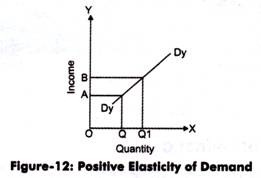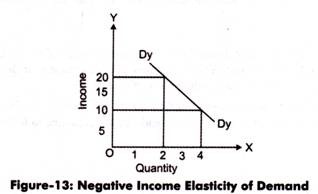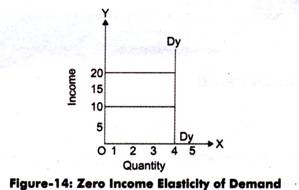Consumer’s income is one of the important determinants of demand for a product.
The demand for a product and consumer’s income are directly related to each other, unlike price-demand relationship.
“Income elasticity of demand means the ratio of the percentage change in the quantity demanded to the percentage in income”-Watson.
For example, the demand for a product increases with increase in consumer s income and vice versa, while keeping other factors of demand at constant. The degree of responsiveness of demand with respect to change in consumer s income is called income elasticity of demand. According to Watson, “Income elasticity of demand means the ratio of the percentage change in the quantity demanded to the percentage in income.”
Measurement of Income Elasticity of Demand:
The income elasticity of demand (ey) can be measured by the following formula:
ADVERTISEMENTS:
ey = Percentage change in quantity demanded/Percentage change in income
Percentage change in quantity demanded = New quantity demanded (∆Q)/Original quantity demanded (Q)
Percentage change in income = New income (∆Y)/original income (Y)
Therefore, the income elasticity of demand can be symbolically represented as:
ADVERTISEMENTS:
ey = ∆Q/Q : ∆Y/Y
ey = ∆Q/Q * Y/∆Y
ey = ∆Q/∆Y * Y/Q
Change in demand (∆Q) is the difference between the new demand (Q1) and original demand (Q).
ADVERTISEMENTS:
It can be calculated by the following formula:
∆Q = Q1 – Q
Similarly, change in income is the difference between the new income (Y1) and original income (Y).
It can be calculated by the following formula:
∆Y = Y1 – Y
The formula for measuring the income elasticity of demand is same as price elasticity of demand. The only difference in the formula is that in the income elasticity of demand, income (Y) is substituted as a determinant of demand in place of price (P). Let us understand the concept of income elasticity of demand with the help of an example.
Suppose the monthly income of an individual increases from Rs. 6,000 (Y) to Rs. 12,000 (Y1). Now, his demand for clothes increases from 30 units (Q) to 60 units (Q1).
The income elasticity of demand can be calculated as follows:
ey = ∆Q/∆Y * Y/Q
ADVERTISEMENTS:
∆Q = Q1 – Q = 60 – 30 = 30 units
∆Y = Y1 – Y = 12000 – 6000 = Rs. 6000
ey = 30/6000 * 6000/30 = 1 (equal to unity)
Types of Income Elasticity of Demand:
Like price elasticity of demand, the degree of responsiveness of demand with change in consumer’s income is not always the same. The income elasticity of demand is different for different products.
ADVERTISEMENTS:
On the basis of numerical value, income elasticity of demand is classified into three groups, which are as follows:
i. Positive Income Elasticity of Demand:
Refers to a situation when the demand for a product increases with increase in consumer’s income and decreases with decrease in consumer’s income. The income elasticity of demand is positive for normal goods.
It is explained with the help of Figure-12:
ADVERTISEMENTS:
In Figure-12, the slope of the curve is upward from left to right, which indicates that the increase in income causes increase in demand and vice versa. Therefore, in such a case, the elasticity of demand is positive.
The positive income elasticity of demand can be of three types, which are discussed as follows:
a. Unitary Income Elasticity of Demand:
Implies that positive income elasticity of demand would be unitary when the proportionate change in the quantity demanded is equal to proportionate change in income. For example, if income increases by 50% and demand also rises by 50%, then the demand would be called as unitary income elasticity of demand. In such a case, the numerical value of income elasticity of demand is equal to one (ey = 1).
b. More than Unitary Income Elasticity of Demand:
ADVERTISEMENTS:
Implies that positive income elasticity of demand would be more than unitary when the proportionate change in the quantity demanded is more than proportionate change in income. For example, if the income increases by 50% and demand rises by 100%. In such a case, the numerical value of income elasticity of demand would be more than one (ey>1).
c. Less than Unitary Income Elasticity of Demand:
Implies that positive income elasticity of demand would be less than unitary when the proportionate change in, the quantity demanded is less than proportionate change in income. For example, if the income increases by 50% and demand increases only by 25%. In such a case, the numerical value of income elasticity of demand would be less than one (ey<1).
ii. Negative Income Elasticity of Demand:
Refers to a kind of income elasticity of demand in which the demand for a product decreases with increase in consumer’s income. The income elasticity of demand is negative for inferior goods, also known as Giffen goods. For example, if the income of a consumer increases, he would prefer to purchase wheat instead of millet. In such a case, the millet would be inferior to wheat for the customer.
Negative income elasticity of demand is shown with the help of Figure-13:
Figure-13 shows that when income is Rs. 10, then the demand for goods is 4 units. On the other hand, when the income increases to Rs. 20, then the demand is 2 units. In Figure-13, the slope of the curve is downward from left to right, which indicates that the increase in income causes decrease in demand and vice versa. Therefore, in such a case, the elasticity of demand is negative.
iii. Zero Income Elasticity of Demand:
Refers to the income elasticity of demand whose numerical value is zero. This is because there is no effect of increase in consumer’s income on the demand of product. The income elasticity of demand is zero (ey = 0) in case of essential goods. For example, salt is demanded in same quantity by a high income and a low income individual.
Figure-14 shows the zero income elasticity of demand:
Figure-14 shows that when income increases from Rs. 10 to Rs. 20, then the demand for goods is remain same, 4 units. In Figure-14, the slope of the curve is parallel to Y-axis (income side), which indicates that the increase in income causes no effect in demand. Therefore, in such a case, the elasticity of demand is zero.
Significance of Income Elasticity of Demand:
While price elasticity plays a significant role in pricing of a product to maximize the total revenue of an organization in the short run, income elasticity of demand is important for production planning and management in the long run.
ADVERTISEMENTS:
Following are some of the important uses of income elasticity of demand:
i. Helping in investment decisions:
Refers to one of the major significance of income elasticity of demand. In developing countries, such as India, the rate of growth of national income is not steady as it is in case of developed countries. Moreover in developing countries, rise in national income does not result in immediate increase in the demand for certain goods.
The concept of national income is very important for sellers as it helps them to allocate their resources in different industries. Generally, sellers prefer to invest in industries where the demand for goods is more with respect to proportionate change in the income or where the income elasticity of demand is greater than zero (ey>1).
For example, the demand for durable goods, such as vehicles, furniture, and electrical appliances, increases in response to increase in the national income. In such industries, sellers earn high profits when there is increase in national income. On the other hand, industries with low income elasticity (ey<1), there is a gradual increase in demand for goods, whereas the demand for goods having negative income elasticity declines when the national incomes grows.
ADVERTISEMENTS:
ii. Forecasting demand:
Refers to the fact that income elasticity of demand help in anticipating the demand for goods in future. If change in income is certain, there would be a major change in the demand for goods. This is due to the fact that if consumers are aware of change in income, they may change their tastes and preferences for certain goods.
On the other hand, if the change in income is temporary, there would be a slow change in the demand. However, the demand for goods in future is also influenced by various factors other than income.
iii. Categorizing goods:
Implies that income elasticity of demand helps in classifying goods, such as normal goods, essential goods, or inferior goods. The classification of goods enables sellers to select the goods to be produced and the quantity of goods to be produced. Apart from this, it also helps sellers to decide the income group to whom the goods should target.
Following assumptions are made while classifying goods:
a. A good would be a normal good, if the income elasticity of demand is positive.
b. A good would be an inferior good, if the income elasticity of demand is negative. For example, millet is inferior to wheat; therefore, the demand for millet is negative.
c. A good would be a luxury good, if income elasticity of demand is positive and greater that one (ey> 1). For example, the demand for cars and air conditioners is income elastic.
d. A good would be an essential good, if income elasticity of demand is positive but less than one (ey< 1). For example, food grains and clothes.
e. A good would be neutral, if the income elasticity of demand is zero (ey=0).


